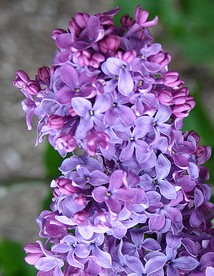 Syringa vulgaris is a deciduous shrub in the olive family (Oleaceae) and is native to the Balkan Peninsula but is widely grown in Europe and the US. It can grow up to twenty three feet tall and has simple oval light green leaves and lilac to white very fragrant flowers that are carried in dense terminal clusters (panicles). According to Greek myth, the nymph Syringa turned her self into the bush which bears her name in order to escape from the Pan, the god of fields and forests, who had the legs and horns of a goat.
Syringa vulgaris is a deciduous shrub in the olive family (Oleaceae) and is native to the Balkan Peninsula but is widely grown in Europe and the US. It can grow up to twenty three feet tall and has simple oval light green leaves and lilac to white very fragrant flowers that are carried in dense terminal clusters (panicles). According to Greek myth, the nymph Syringa turned her self into the bush which bears her name in order to escape from the Pan, the god of fields and forests, who had the legs and horns of a goat.
Lilac flowers taste sweet, like their fragrance but with an slight undertone of bitterness. They are most commonly added to salads but can be used to flavor pudding, pastry cream, sorbet, ice cream, and baked goods such as scones. Lilac flowers can also be made into wine, jam, jelly and a syrup to that can be used with desserts, tea, and rum or gin for a cocktail. Crystallized flowers are especially pretty on small confections such as petite fours.
Clusters of flowers should be cut from the branches, washed, and then individual blossoms removed from the green calyx. The stigma and stamens may be left in the flowers. Forty to sixty flowers yields about one cup.